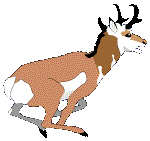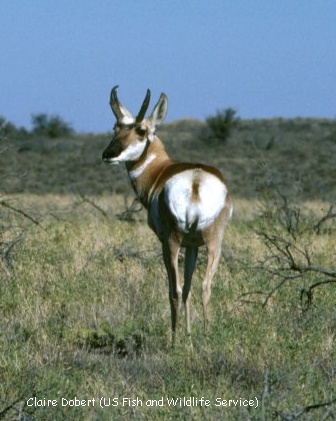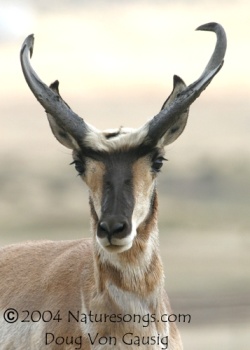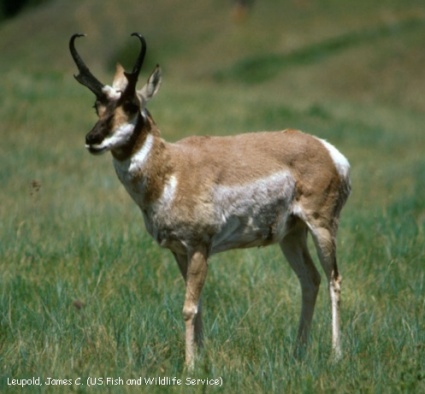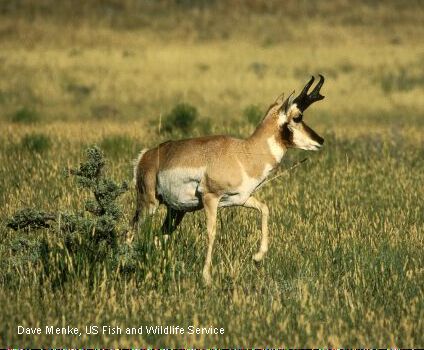Where it is found
In Canada the pronghorns live
on the grasslands of southwestern Saskatchewan and southeastern Alberta.
They also roam the grasslands and desert-like areas of western United States.
Appearance
The pronghorn is a deer-like animal with long thin legs
and dark horns.
The coat is mostly tan or light brown.
There are patches of white on the face, neck and chest. The sides and
belly are white.
On each side of the tail is a patch of white hairs.
When the pronghorn is alarmed the white hairs stand up.
The name "pronghorn" comes from the unusual shape of the
horns. ( the forward pointing prongs ). Females have smaller
horns. In the fall or early winter the horns drop off as
the new horns start to grow.
(used with permission)
Food
The pronghorn searches for food from dusk to dawn.
It is constantly on the move looking for sagebrush, weeds,
and grasses.
Enemies
Humans, wolves, coyotes and golden eagles hunt the pronghorn.
Protection
It relies on very good eyesight and speed to escape enemies.
The pronghorn can run at a speed of over
100 km per hour. (60 mph) The pronghorn is the fastest land animal in
North America.
When it is cornered it fights back with its sharp
hooves and butts with its horns.
The young
The female usually has twins but she may also have triplets.
The fawns are born in late spring.
Newborns are greyish-brown. They are odourless ( do not give
off a scent ) so that enemies can not find them. The mother
leaves her young in tall grasses while she grazes.
In a few days the fawns are able to run.
Adaptations
They gather in groups for the summer and
form large herds for the winter.
During cold weather they may migrate in search of food
and to get away from the deep snow. With their hooves
they dig under light snow to get to the plants.
The pronghorn’s thick coat keeps the animal warm even in very cold weather.
In summer the animal moults ( loses hair ) and the coat thins out.
They have remarkable eyesight and can spot enemies over
4 km. away (3 miles). When an enemy is spotted they speed away.
The life span of the pronghorn is 7 to 10 years.
Decrease in numbers
When settlers first arrived in this country
there were millions of pronghorns. Many were shot
for food and for sport. As more people settled
the grasslands were turned into farmland. Barbed wire fences were built to
keep out the pronghorns.
The open areas where the animals roamed
freely disappeared and so did the pronghorns.
By the 1920s there were about 20,000 left.
The Sonoran pronghorn which lives in the Sonoran Desert of southern Arizona and Mexico
remains endangered.
CANADIAN ANIMALS - index
| 